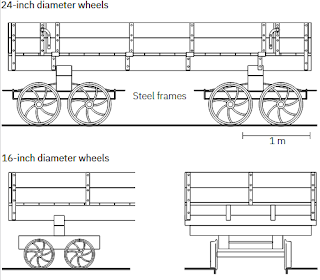Back in November last year 3 foot 6 models was created to break the Shapeways monopoly on 3D printing of NZ120 models. I've managed to hold off doing any shopping for quite a while now. However in May the English Electric Dm/D EMU set came onto the list. Now off and on for years I've looked at these models on Shapeways but the price has keep my credit card in my wallet. With the cost dropping to $80 for a 2 car set (or $100 for the 3 car set) I clicked on the button. While waiting for my turn in the print cue, the devilishly cunning Mr Holden listed the Ew on a list of test prints. Hoping to bump it to the top I offered to take to first test print. Click. I'm still wondering why I'm doing this as Paekakariki isn't moving off the back wall of the garage any time soon. Anyhoo...
Tonight the box was waiting for me.
 |
Maths is not his strong suit....
|
First impressions are good. The general dimensions are about right. The corners could be a bit more rounded, but thats more a function of the CAD programs limits. A little bit of work with a file and sandpaper with reference to photos of the real thing solves this.
The one comment is that (I think, looking at photos) the roof ventilators are the wrong shape, and should be square (in the early 1970's anyway). Theres also a couple of very small spots on one model that need filling and a couple of gaps in the cowcatchers that will need filling. I'm also a bit stumped on how to glaze the windows (oh and if anyone has pictures of the area round the pantograph I'd be keen)
So, a solid 4 out of 5 and I'm planning to buy a second 3 car set at some point.
Second up is the Ew. Its a test print and the details on the sides seem a bit soft and could stand out a bit more. However looking at the CAD picture on Shapeways its in the CAD file. Again the dimensions seem to be about right. A 3 out of 5 at the moment but I've sent comments back to Lewis and the production models should be of a higher standard.
 |
| The printing lines in the photo don't show up at all in real life. |
|
Lewis was also able to send me a couple of pictures taken during the process.
 |
Fresh off the press
|
 |
Taking a spin on the UV curing turntable.
|
Finally, the bogies. These are simply detailed, with plenty of space to add the extra fiddly bits if you want. There are brake shoes added as well which fit 7mm wheels. The axle centers are 19mm, so 1mm short of the 20mm/8' of the real thing. The bogies are also printed just a wee bit wide so the Parkside-Dundas wheelsets are on the verge of dropping out of the pinpoints. If I cut a slice out of the ends and re-glue them together it should work out OK.
So overall I'm quite happy with these models. The D/Dm set particularly provide a good starting point for the more experienced modeler to go to town, but a also a "good enough" model for a keen beginner.
%201982-04-07%20leads%204-car%20set%20nr%20Woburn%20-%20INL.png)









.jpg)


